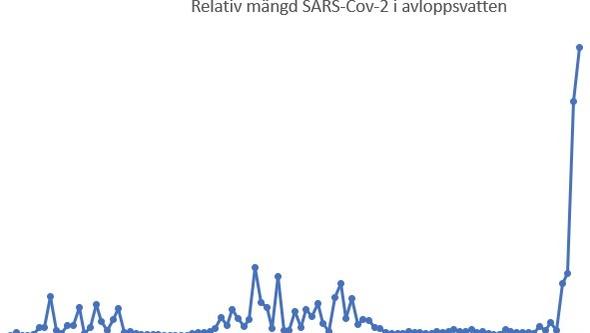In Gothenburg, concentrations of coronavirus in wastewater have risen further in a week. Now, for the first time, the University of Gothenburg scientists have released a trend chart for the whole pandemic.
The research group headed by Heléne Norder, adjunct professor of microbiology at Sahlgrenska Academy, University of Gothenburg, have chosen this week to make an exception and present the nearly two-year trend of SAR-CoV-2 in wastewater, in the city and its outskirts, in chart form.
As the chart shows, there has been a further rise in the past week. The new record measurement is based on samples taken between 10 and 16 January. Above all, it illustrates clearly how high the current peak is compared with those in the previous - first, second, and third - pandemic waves.


"It's hard to understand the situation when we say the figures are 'x' or 'y' times higher than before, but the trend shows clearly how they've risen and how widespread the infection is today. We need to show how dire the situation is right now, so that maybe those who aren't infected can grasp the seriousness of the situation and, now and again, put a face covering on," Norder says.
Soon two years of surveys
These surveys of SARS-CoV-2 in wastewater have been underway since February 2020. They are done in collaboration with municipally owned Gryaab, which carries out wastewater treatment in Gothenburg and the surrounding municipalities. The company sends one sample a week, containing samples collected daily, to Heléne Norder's research group.
Norder performs the actual calculations. The researchers in charge of the testing are Timur Tunovic, Hao Wang, Marianela Patzi Churqui, and formerly also Fredy Saguti. Another key group member is associate professor of medical microbiology Kristina Nyström.
The group reports its results continuously to care providers and the Infection Control Unit in Region Västra Götaland. To a varying degree, the increased concentrations of coronavirus in the wastewater, and the corresponding rise in the prevalence of COVID-19 in the community, have made it possible to predict peak loads in health care during the pandemic.
Wastewater levels even more important
Heléne Norder emphasizes that measuring and analyzing wastewater becomes even more important if the level of testing for COVID-19 changes owing to variation in the supply of tests and lab capacity, or for other reasons.
"Now that we're about to reduce the testing, it's in the wastewater that we see whether infection and its spread are going up or down in the Gothenburg area," she points out.
As for variants of the virus, omicron remains overwhelmingly predominant. However, the latest survey shows that the delta variant is persisting, at approximately 1 percent. This proportion nonetheless reflects virus concentrations and not necessarily the proportion of people infected.






